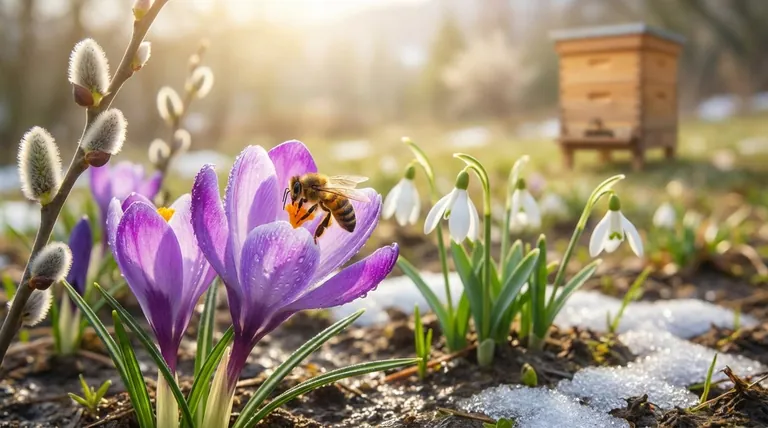While there is no single calendar date, honey bees typically begin to emerge and forage in early spring, around April in many temperate climates. This activity is not triggered by the month itself, but by two critical environmental cues: consistently warmer daytime temperatures and the first blooming flowers that provide nectar and pollen.
The core concept to understand is that honey bees do not hibernate; they survive winter by clustering for warmth inside the hive. Their emergence in spring is a gradual process dictated by daytime temperatures rising above 50-55°F (10-12°C), which is the minimum threshold required for flight.

The Trigger for Spring Activity: Temperature and Food
The re-emergence of a honey bee colony is a direct response to a changing environment. They are waiting for specific signals that tell them it's safe and productive to leave the hive.
The Winter Cluster
Throughout the cold months, honey bees are not dormant. They form a tight cluster around their queen, shivering their flight muscles to generate heat and maintain a core temperature of around 90°F (32°C). They survive by consuming the honey they stored during the previous summer.
The Temperature Threshold
A bee's ability to fly is entirely dependent on temperature. Below 50°F (10°C), their flight muscles are too cold to function. The first warm, sunny days of spring, even in late February or March, may trigger brief "cleansing flights" where bees exit the hive to relieve themselves after a long winter confinement.
The Availability of Food
Consistent foraging only begins when temperatures are reliably above 55°F (12°C) and food sources become available. The blooming of early spring flowers like crocuses, willows, and maples is the true starting gun for the colony's season of work.
From First Flights to Peak Activity
The colony's activity level builds in distinct phases from early spring through summer.
Early Spring (March-April): Initial Foraging
Once temperatures allow, worker bees begin searching for the first sources of pollen and nectar. This initial income of resources stimulates the queen to dramatically increase her egg-laying, beginning the process of rebuilding the colony's population.
Late Spring (May-June): Population Boom
As the floral bloom intensifies, the hive experiences a rapid population increase. The abundance of food allows the colony to raise thousands of new worker bees, strengthening the workforce for the main summer honey flow.
Summer (June-July): Peak Activity and Swarming
This is when the colony is at its most populous and active. If the hive becomes overcrowded and resources are plentiful, the bees may enact their natural form of reproduction: swarming. The old queen leaves with about half the bees to find a new home, leaving the original hive to a new queen.
Understanding the "Off-Season"
A common misconception is that bees disappear in winter. Their activity is simply hidden from view and follows a predictable cycle of preparation and survival.
What Happens in Autumn?
As days shorten and temperatures fall, the queen's egg-laying rate slows dramatically. Worker bees expel the male bees (drones) from the hive, as they serve no purpose during the winter and would be a drain on food stores.
Why You Might See a Bee on a Warm Winter Day
An unusually warm and sunny day in January or February can trick a few bees into leaving the hive for a brief cleansing flight. This is normal behavior and does not signify an early spring; the colony will retreat back inside as soon as the temperature drops.
Applying This Knowledge to Your Goals
Understanding the honey bee's seasonal cycle allows you to interact with them more effectively, whether you're a gardener, beekeeper, or curious observer.
- If your primary focus is gardening: Plant early-blooming flowers like crocus, snowdrop, and witch hazel to provide a critical first food source for emerging bees.
- If your primary focus is beekeeping: Use rising temperatures as your cue to check on hive health and food stores after winter, and prepare for swarm management in late spring.
- If your primary focus is observation: Look for bees on the earliest spring blossoms as a key indicator that the local ecosystem is beginning to wake up.
By recognizing that temperature and food sources, not the calendar, dictate their lives, you gain a deeper appreciation for the resilience and natural rhythm of the honey bee colony.
Summary Table:
| Key Event | Typical Timing | Trigger |
|---|---|---|
| First Cleansing Flights | Late Winter (Feb-Mar) | Brief warm spells >50°F (10°C) |
| Initial Foraging Begins | Early Spring (Mar-Apr) | Consistent temps >55°F (12°C) & first blooms |
| Population Boom | Late Spring (May-Jun) | Abundant nectar & pollen sources |
| Peak Activity & Swarming | Summer (Jun-Jul) | Maximum colony strength & resources |
Ready to Support Your Bees This Spring?
As your colony's activity ramps up, having the right equipment is crucial for a successful season. HONESTBEE supplies commercial apiaries and beekeeping equipment distributors with the high-quality, wholesale-priced supplies they need to thrive.
From hive components and protective gear to honey extraction systems, we help you manage your bees' natural cycles efficiently and profitably.
Let's gear up for the honey flow together. Contact our team today to discuss your wholesale needs!
Visual Guide

Related Products
- Commercial Grade Vertical Electric Bee Sweeper for Bee Removal
- Professional Grade Foldable Beehive Handles
- Multi-Function Hive Tool with Integrated Hammer for Beekeeping
- High Performance Cordless Electric Bee Shaker for Beekeeping
- HONESTBEE Heavy Duty All Metal Frame Wire Crimper Tool
People Also Ask
- What do you use a bee brush for? Gently Manage Your Hive Without Harming Bees
- What qualities are important for someone starting in beekeeping? Build a Thriving Apiary with the Right Mindset
- How do beekeepers use a blower in honey extraction? Efficiently Clear Bees for a Purer Harvest
- What is the purpose of a bee brush? Gently Manage Your Hive with Precision
- How does the Auto Flow Hive reduce labor and time for beekeepers? Streamline Your Honey Harvest



















